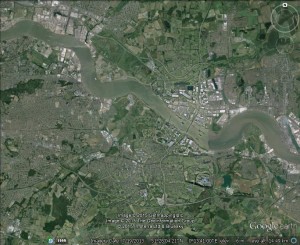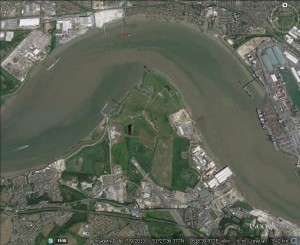Peter Beckenham of Braeburn Park/LWT fame has asked us to put up something about the Swanscombe marshes/peninsula, which we have in fact been meaning to do for some time. What does this have to do with Bexley? Well, the Swanscombe peninsula is a large staging post for birds between the Hoo Peninsula and Dartford/Crayford Marshes, Rainham and then Crossness as the remnants of our marshland peter out towards central London, and an important site in its own right. For some time now plans have been gathering momentum to plaster it with a giant ‘theme park’, with little visible opposition. In short, it’s yet another case of the early 21st century ‘we all care about the environment now’ rhetoric being trumped by the same old 20th century fixation with unsustainable‘development’ as the local authorities in the area see a jobs ‘bonanza’, and never mind whether they’re the sort of jobs that help wean us off our 3-planet lifestyle and what the immediate cost to nature is. Do help get the word out and make it that little bit harder for the concrete merchants to have their way!

Google Earth image showing (from left) Crossness (Erith Marshes), Crayford/Dartford Marshes (with Rainham opposite) and then the marshes of the Swanscombe peninsula as green ‘oases’ along the otherwise hemmed in Thames shoreline.
Peter says:
‘Swanscombe Marshes is a site I know well and one that is up for an appalling new development on a vast scale (c500ha) that will have repercussions along the Thames corridor.
It’s a wonderful site, consisting of extensive reedbed, wet grassland, scrub and significant areas of bare, rocky ground between Gravesend and Dartford. It has some special wildlife including a spider – the Distinguished Jumping Spider – that is critically endangered and known from only one other site in the UK. Then there are the breeding skylarks, the cuckoos, the adders, water voles etc. Ravens nested there last year, a bird that was, until recently, extinct in Kent for over 100 hundred years.
The non-existent mitigation plans currently propose keeping isolated fragments of marsh plus a ‘country-park’ style landscaped area for people.
Kent Wildlife Trust are aware of the plans and have been in touch with the ecological consultants who are undertaking surveys at the moment.

Swanscombe marshes/peninsula – reclaimed by nature and now a fantastic home for wildlife. (Google earth image)
I thought it was time that something, however small, was put out there to focus on the positives, i.e. it’s wealth of flora and fauna, its open skies and interesting post-industrial landscape. My experience of the public consultations so far is that far too few people even know about the plans, yet alone their relative impacts and there is already a sense that it is a ‘done deal’. Swanscombe marshes unfortunately suffers in a similar way to Lodge Hill on Hoo, in that it is ‘brownfield’ land – and we know that to the inexperienced eye, it looks like a ‘wasteland’. But nature has recovered well in the disturbed, low-nutrient conditions and perhaps just as important is the space and solitude it affords. I became continually frustrated by the negative language used to describe the site (and others similar) which led to me starting this.
http://www.saveswanscombemarshes.com
we’re on twitter @SaveSwanscombe
I will be monitoring it as best I can though at times I will be away in Cyprus with BirdLife.
There will be a petition later in spring but I would be very grateful if you could perhaps pass on details of the website to friends, colleagues and those concerned about wildlife. We need twitter followers, fans, photographs, everything!’
More information on the developers:
http://www.londonparamount.info/
Way back in 2012 Bexley Natural Environment Forum asked the head of the Greater Thames Marshes Nature Improvement Area (GTM NIA) why both Dartford marshes and Swanscombe marshes had been left out of the boundary whilst Crayford Marshes and Erith Marshes were within it. The response was that the bid limit was 50,000ha and maybe they could get back to these other areas that had not been included at a future date. In the meantime we have seen no evidence of any action by the NIA team at either Crayford Marshes (still under threat from a whopping freight distribution centre) or Erith Marshes.

Pingback: Bexley RSPB see wealth of birdlife at threatened Swanscombe marshes | Bexley Wildlife